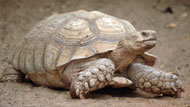Description:
The African spurred tortoise is also called the spurred tortoise or sulcata. The sulcata used to be a rare tortoise but because of successful captive breeding it is now one of the most common tortoises in captivity. So much so that it is considered a problem because some keepers do not give the tortoise the thought that is required when obtaining one. They then find that they do not know what to do with a 50 pound plus monster and end up placing it up for adoption. The sulcata can attain a very large size in a relatively short time so care for this tortoise must be thought out carefully with accommodations being the primary concern. Sulcatas enjoy a temperature range of 80 to 100 degrees Fahrenheit. This tortoise is best considered for warmer climates where it can be maintained in a large outdoor enclosure with the range extending into cooler climates with the use of supplemental heating. Sulcatas are not only capable burrowers but frequently do dig burrows when given the opportunity which can be over 2 foot in diameter and over 15 feet in length. For this reason they should be provided with housing that they should be encouraged to use. In their native range food and water is relatively sparse with reports of them feeding mainly on succulent plants and grasses. In captivity the Sulcata is an opportunistic feeder where it readily takes almost any vegetable matter but grasses and dark leafy greens are the most common staple. Even though sulcata are considered desert type tortoises water, should be provided at all times.
Habitat:
Semi-desert, Grassland and Woody scrub land.
Range:
Found within the Sahel region, which is a geographical band in Africa south of the Sahara desert stretching from Mauritania and northern Senegal eastward to northern Ethiopia.
Scientific Name: Geochelone (Centrochelys) sulcata
Species Group: tortoise
Family: Testudinidae
Size: The African spurred tortoise is also called the spurred tortoise or sulcata. The sulcata used to be a rare tortoise but because of successful captive breeding it is now one of the most common tortoises in captivity. So much so that it is considered
Level: advanced
Weight: n/a
Dangerous: No



